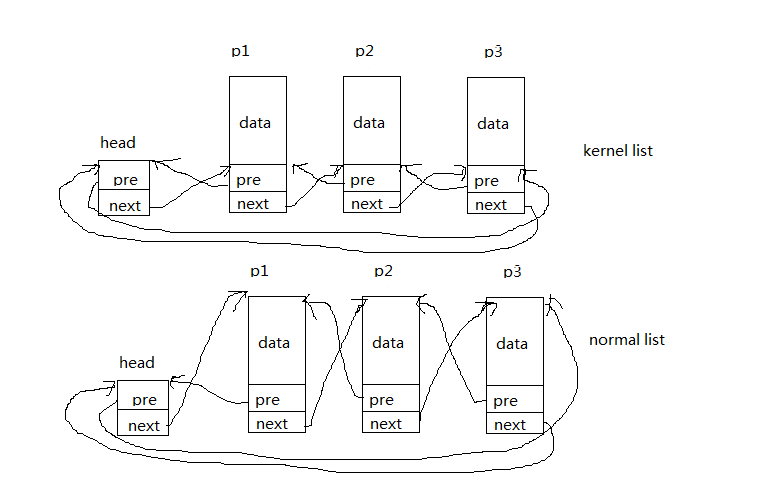轉載自:http://blog.csdn.net/linux_wgl/article/details/7308133
內核鏈表和普通鏈表的區別
內核鏈表是一個雙向鏈表,但是與普通的雙向鏈表又有所區別。內核鏈表中的鏈表元素不與特定類型相關,具有通用性。
我們先來看一幅圖
 kernel list展示的是內核鏈表的結構,normallist展示的是普通鏈表的結構。head是鏈表頭,p1,p2,p3是鏈表節點。從圖中可以看出普通鏈表的p1的next指針是指向的結構體p2的地址,p2的pre指針指向p1結構體的地址。而內核鏈表的p1的next指向的是p2結構體中包含pre和next部分的地址,的p2的pre指向的是p1結構體中包含pre和next部分的地址。依此類推,這就是區別。內核結構元素不與特定類型結構相關,任何結構體都可通過內核的添加成為鏈表中的節點。
kernel list展示的是內核鏈表的結構,normallist展示的是普通鏈表的結構。head是鏈表頭,p1,p2,p3是鏈表節點。從圖中可以看出普通鏈表的p1的next指針是指向的結構體p2的地址,p2的pre指針指向p1結構體的地址。而內核鏈表的p1的next指向的是p2結構體中包含pre和next部分的地址,的p2的pre指向的是p1結構體中包含pre和next部分的地址。依此類推,這就是區別。內核結構元素不與特定類型結構相關,任何結構體都可通過內核的添加成為鏈表中的節點。
#include <linux/kernel.h>
#include <linux/module.h>
#include <linux/init.h>
#include <linux/slab.h>
#include <linux/list.h>
MODULE_LICENSE("GPL");
MODULE_AUTHOR("David Xie");
MODULE_DESCRIPTION("ListModule");
MODULE_ALIAS("List module");
struct student
{
char name[100];
int num;
struct list_head list;
};
struct student *pstudent;
struct student *tmp_student;
struct list_head student_list;
struct list_head *pos;
int mylist_init()
{
inti = 0;
INIT_LIST_HEAD(&student_list);
pstudent= kmalloc(sizeof(struct student)*5,GFP_KERNEL);
memset(pstudent,0,sizeof(structstudent)*5);
for(i=0;i<5;i++)
{
sprintf(pstudent[i].name,"Student%d",i+1);
pstudent[i].num= i+1;
list_add(&(pstudent[i].list), &student_list);
}
list_for_each(pos,&student_list)
{
tmp_student= list_entry(pos,struct student,list);
printk("<0>student%d name: %s\n",tmp_student->num,tmp_student->name);
}
return0;
}
void mylist_exit()
{
inti ;
for(i=0;i<5;i++)
{
list_del(&(pstudent[i].list));
}
kfree(pstudent);
}
module_init(mylist_init);
module_exit(mylist_exit);